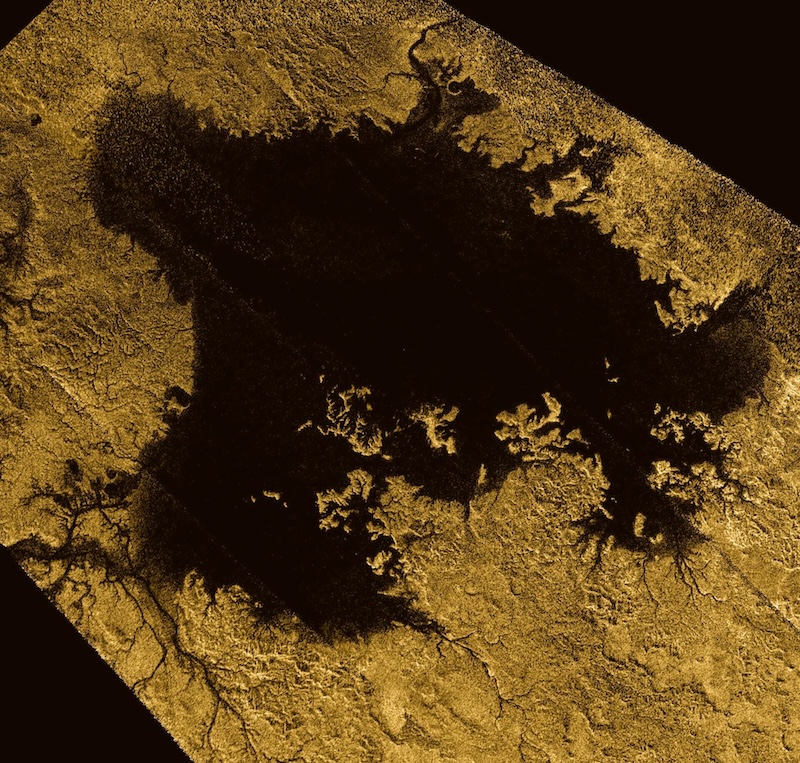
- Saturn's large moon Titan has seasThe seas are liquid, but the liquid is not water, but methane and ethane.
- Researchers obtained information about the seas Using radar data from the Cassini mission, they observed variations in roughness and composition, as well as the reflectivity of seas and surface waves.
- They discovered that Titan's seas behave very similarly to bodies of water on Earth.despite being composed of methane and ethane, the researchers said they are influenced by similar meteorological processes and mixing dynamics.
Late last month, researchers saying The methane and ethane seas of Saturn's moon Titan (and smaller lakes on Titan) have waves that shape their shorelines. Now, another international team of researchers has learned more about Titan's alien seas. Using NASA radar data, researchers have discovered the seas of Titan that are known as the “seas of the universe.” Cassini mission, the team saying On July 16, 2024, NASA announced that it had made new findings about the roughness and composition of Titan's seas. One fascinating result: Rivers that flow into Titan's seas mix methane and ethane, they said, in a way similar to freshwater rivers that flow into Earth's saltwater oceans.
The researchers published he peer reviewed results in Nature Communications July 16, 2024.
Cassini radar data
Cassini's mission to Saturn and its moons ended on September 15, 2017, but there is still tons of data left for scientists to analyze, including radar data. Cassini used its radar to study Titan's seas and lakes. Some of the radar data is monostaticMonostatic radars use a single transmitter, receiver and antenna. Monostatic radars on EarthBoth the transmitting and receiving antenna are close to each other at a radar station at the same location.
But Cassini also had bistatic Radar, which is made up of multiple monostatic radars of the same frequency. On Earth, the transmitting and receiving antennas are placed far apart from each other. In the case of Cassini, it directed a radio beam from the spacecraft to Titan, which then reflected it back to the receiving antenna on Earth. That reflection is polarized. That means it provides information gathered from two independent perspectives, rather than just one as with monostatic radar data. This makes it more useful than using monostatic radar alone.
Primary author Valerio Poggiali at the Cornell Center for Astrophysics and Planetary Sciences (CCAPS) at Cornell University in Ithaca, New York, said:
The main difference is that bistatic information is a more complete data set and is sensitive to both the composition of the reflecting surface and its roughness.
Co-author Philip Nicholsonin the Department of Astronomy (A&S) at Cornell University added:
Successful execution of a bistatic radar experiment requires exquisite choreography between the scientists designing it, the Cassini mission planners and navigators, and the team collecting the data at the receiving station.
Observing Titan's 3 largest seas
Cassini made three bistatic radar observations of Titan's seas in 2014 on May 17, June 18, and October 24, and one in 2016 on November 14. It observed radar reflections off the surface as it approached Titan (ingress) and as it moved away again (egress).
Cassini observed Titan's three largest seas: Kraken Mare, Ligeia mare and Punga mare.
Scientists know that Titan's seas, lakes, rivers and rains are composed of methane I ethaneThe new results of the analysis refine this further.
The surface layers of the seas vary in composition, depending on location and latitude. Taking this into account, the southernmost part of Kraken Mare had the highest dielectric constantOn Titan, that's a measure of the seas' ability to reflect radio waves. The results showed that seas and lakes are much less reflective than those made of water on Earth. On Earth, water has a dielectric constant of about 80. But on Titan, it's typically only about 1.7.
In addition, the data provided more details about the waves. As detected by Cassini, surface waves were no more than 3.3 mm high. They were slightly higher near coasts, estuaries and straits between basins – up to 5 mm. This may indicate active tidal currents.
Titan's seas behave very similarly to those on Earth.
There are also differences in composition between rivers and seas, with similarities to Earth. Poggiali said:
We also have evidence that the rivers that feed the seas are pure methane until they flow into the open liquid seas, which are richer in ethane. It is like on Earth, when freshwater rivers flow into and mix with the salt water of the oceans.
As Nicholson also noted:
This fits perfectly with Titan's weather models, which predict that the “rain” falling from its skies is likely to be nearly pure methane, but with traces of ethane and other hydrocarbons.
Even with this new study, there is still much to learn about Titan's seas. The data Cassini sent back to Earth will keep scientists busy for many years to come. Poggiali said:
There is a mine of data still waiting to be further analyzed in ways that will lead to further discoveries. This is just the first step.
From NASA Dragon-fly is the next big mission to Titan. The large drone-shaped helicopter will arrive in 2034 and fly to dozens of locations on Titan.
Bottom line: A new analysis of Cassini radar data shows that Titan's seas and hydrologic systems behave very similarly to those on Earth despite their different compositions.
Source: Surface properties of Titan's seas revealed by Cassini mission bistatic radar experiments
Read more: Titan's sea coasts were likely shaped by waves
Read more: Titan's ancient lake may have lasted for thousands of years